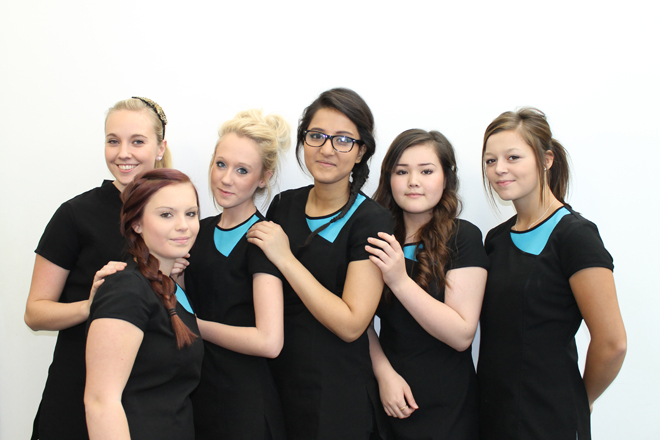School of thought
It’s a chilly winter morning and the girls are shuffling into the classroom-cum-salon. With a level of chatter you’d expect from a dozen 16-year-olds, they change into their uniforms and gather at their workstations for the morning’s manicure and pedicure lesson.
I’ve been invited by their tutor, Emma Harrison, to go behind the scenes at Oxford Academy’s new beauty therapy facility, which launched at the start of this academic year. This is the first time the Academy, a school that teaches students from 11 through to 18 or 19, has offered beauty therapy, and the course is still in its infancy. “I’m the only teacher, so I do as much as I can,” explains Harrison, formerly a trainer at Nirvana Spa in Wokingham. “Once we’re more established and we’ve got loads of students, we can expand.”
Harrison speaks with the enthusiasm of one launching a new venture. Having come from a spa background, she is aware of the criticisms employers have of beauty education, and has plenty of ideas to develop her students into employable young therapists. She tells me of plans to run open evenings for local employers to see the girls’ skills, and has taken her class to an elderly people’s home to offer manis to residents.

New school
Oxford Academy’s beauty course reflects the changing landscape of beauty education. It’s becoming more common to see schools offering beauty therapy courses, not just to sixth formers but to under-16s as well, and since Government changes came into force making it compulsory for students to stay in full time education until they’re 18, more are looking to vocational subjects like beauty.
“We’re ahead of the game now the law has changed. I think next year the intake will be huge. Already the younger ones, year 7s and 8s, are asking when they can come and do it,” says Harrison.
But with these changes come a fresh set of challenges to a sector of the industry that is already overstretched. “Having Level 1 courses adds a whole new dynamic to the department,” explains Heather Terrington, programme leader in beauty therapy at Wiltshire College. “You have to make sure you are inclusive and make opportunities available to all of them.”
The pressure on schools and colleges can’t be underestimated. Slashes to budgets mean depleted teaching resources, bigger class sizes, and fewer contact hours with students, all of which ultimately impacts the quality of training.
In an industry that offers so little on-the-job training (there were around 1,500 registered beauty apprentices in 2011-12, compared to 10 times that number for hairdressing) many employers make no bones about the poor quality of therapists coming out of colleges.
“I used to have a salon, and it was so hard taking girls from college because they just weren’t able to hit the ground running,” explains Pamela Moss, a former college tutor from the Hampshire area, who now runs private make-up school Sassy & Beau. “You had to practically retrain them. A lot of other salon owners I knew said the same thing.”

Tough tutors
Ruth Travis, a salon owner and nails coordinator at Accrington and Rossendale College, says such criticisms can be frustrating, given the challenges tutors face. “Employers don’t really see the time frame that we have to deliver the subjects in and the class sizes we’re up against,” she says.
Terrington explains that her NVQ Level 3 course, which used to be taught over two years, is now only taught over one, meaning students do not have as much opportunity to practise treatments such as depilation at college, placing more emphasis on practising at home or in work experience. This means that while students are able to do certain treatments, they lack the polish to deliver them at a level that clients would expect.
Moss set up her school a year ago, because she felt frustrated that the education in colleges wasn’t enough to prepare therapists for a professional salon. “In college you’re so bound by the systems they have already. I don’t think it’s very progressive,” she says. “College programmes haven’t moved on as fast as the trends in the salons.”
She believes colleges, and qualification-awarding bodies, need to work more with salon owners to “make sure that gap is as small as possible”. That could be set to happen, as Habia is preparing for a review of the National Occupational Standards for beauty therapy, which begins in April, and has called for input from therapists, nail techs and make-up artists.
“It’s a very fast-changing industry, and we have to work hard to make sure students are aware of, even if they’re not qualified in, the treatments that are available,” says Terrington. Moss believes that courses taught by tutors who still work part time in the trade tend to be more progressive. “We all still work in industry and that’s a huge benefit to students, knowing we’ve all got our fingers on the pulse,” adds Travis.
Offering an up-to-date course is also important if colleges want to be attractive to prospective students. “They’ve started to be more savvy about what’s available,” says Travis. “As a college you’ve got to be really on the ball with what you’re offering. It’s a business at the end of the day, so you’ve got to be competitive.”

Fill the gap
Employers and operators often lament the skills gap in newly qualified therapists, and tutors seem to be fully aware of its presence. “We actually get our students to do 60 hours of work experience during their Level 3 year because of that issue,” says Melissa Nighy, beauty therapy tutor at East Surrey College, adding that she encouraged students to do work experience even before it was a compulsory element of the course. Likewise, Terrington says her students must complete two weeks on reception at the college’s Aspire salon to develop their customer service skills.
Alongside encouraging practical experience, the tutors are proactive in inviting salon and spa owners in to give students career advice. Travis takes advantage of her contacts in the industry, inviting them to speak to her students, but says that is always down to goodwill. Nighy frequently takes her students out to visit big, luxury spas such as nearby Alexander House, to see how businesses run day to day.
Terrington also describes a strong relationship with nearby businesses, which include some prestigious spas in Bath. She uses local employers as mystery shoppers in the Aspire salon, who will then give feedback directly to the students.
“I decided early on that we needed more interaction with employers so we had an open day; we got them in and talked to them,” says Terrington. She amends certain areas of training in line with the employers’ feedback. For example, the college now teaches hands-free massage techniques, and does gel polish training with the Level 2 students.
Nighy offers enrichment to her students, by inviting brands in to do training. Her students have done a one-day training course in intimate waxing with Lycon, she explains, and have also covered brow threading and glycolic peels. “I do it to try and build up their CVs,” she says. “So when they’re going into salons, people will see that they haven’t just got their basic qualification, they’ve got lots of other things going on as well.”
Terrington agrees, saying, “We’ve got to train them to be employable.” Wiltshire College is a Centre of Excellence for the iiaa, whose staff come in and train students in addition to their normal learning hours. “They do a lot of CPD, which is certificated,” she says. “The students buy in to that in a big way; it makes them feel professional from the word go.”
Forward thinking
It’s often these above-and-beyond steps that help make students stand out from the crowd when they come to look for jobs. Terrington attributes the high employment rate of her students in part to the mystery shopper initiative she runs. Nighy explains that her students who take part in industry competitions, notably Carlton’s Sebta scheme, have quickly gone on to have impressive careers.
What is clear is that these initiatives are reliant on enthusiastic lecturers who are prepared to go the extra mile for their students. Nighy talks about spending full days at trade shows networking with brands to discover the latest trends to pass on to her students, and inviting trainers in to talk to them.
But tutors can only do so much without the support of brands and employers. Nighy says that while many brands have been proactive in coming into colleges, there are some big skincare houses that pay no attention.
“If the industry could only spare some time to come into colleges and see students, that really inspires them,” she says, frustrated at the criticisms of young therapists laid at the tutors’ doors. “If employers are not happy, you need to come and talk to us.”
“I think at the moment newly qualified therapists have a bad reputation; you’re all tarred with the same brush if you’re new,” says Harrison. “I’ve heard employers go on for ages about how they’re unhappy, but nothing happens, does it? People say, ‘I wouldn’t take on college leavers’ and we just accept it. So what happens to the newly qualified ones?”

